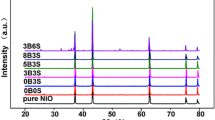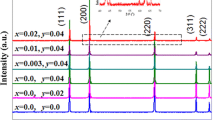The electrophysical properties of BeO-based ceramics with introduced micro- and nanoparticles of TiO2 were investigated by impedance spectroscopy in the frequency range of 100 Hz – 100 MHz. In order to increase the density and conductivity, the initial ceramic components were sintered at the highest possible temperatures up to 1660°C, followed by annealing in hydrogen at 800°C. In this case, TiO2 was strongly reduced with the formation of lower titanium oxides (Ti3O5) along with metallic titanium. When interacting with hydrogen, TiH2 is formed. For the first time, impurity phases were found in (BeO + TiO2) ceramics, which can significantly alter its bulk and surface properties. The resulting ceramics has a high reach-through conductivity, which increases significantly after an additional thermal annealing in hydrogen. It was established that the activation energy of conductivity does not depend much on the concentration of TiO2 nanoparticles and decreases significantly in the low-temperature region. The method of constructing equivalent electrical circuits was used to simulate the passage of the active and reactive components of the current through the complex internal structure of the ceramics.






Similar content being viewed by others
References
A. Markov, O. Savinskaya, M. V. Patrakeev, et al., “Structural features, nonstoichiometry and high-temperature transport in SrFe1-xMoxO3–δ,” Journal of Solid State Chemistry, 182, 799 – 806 (2009).
M. D. Glinchuk, P. I. Bykov, and B. Hilcher, “Specifics of ionic conductivity of oxygen in oxide nanoceramics,” Fizika Tverdogo Tela (FTT), 48(11) (2006).
A. M. Solodukha and Z. A. Lieberman, “Specifics of hopping conductivity in bismuth-containing oxide layered ceramics,” Fizika Tverdogo Tela (FTT), 43(11) (2001).
C. Ang and Z. Yu, “Effect of annealing on dielectric behavior and conduction transport of Bi doped SrTiO3,” Appl. Phys. Lett. American Institute of Physics, 88(16), 162902 (2006).
V. S. Kiiko, M. A. Gorbunova, Yu. N. Makurin, et al., “Microstructure and electric conductivity of composite (BeO + TiO2)-ceramics,” Refract. Ind. Ceram., 48(6), 429 – 434 (2007).
N. A. Drokin, V. S. Kiiko, A. V. Pavlov, et al., “BT-30 ceramic electrophysical properties,” Refract. Ind. Ceram., 61(3), 341 – 348 (2020).
M. Landmann, E. Rauls, and W. G. Schmidt, “The electronic structure and optical response of rutile, anatase and brookite TiO2,” J. Phys.: Condens. Matter., 24(19), Article No. 195503 (2012).
T. Thompson and J. Yates, “Surface science studies of the photoactivation of TiO2 — new photochemical processes,” Chemical Reviews, 106, 4428 – 4453 (2006).
H. Tang, K. Prasad, R. Sanjines, et al., “Electrical and optical properties of TiO2 anatase thin films,” Journal of Applied Physics. American Institute of Physics, 75(4), 2042 – 2047 (1994).
N. G. Bukun and A. Ye. Ukshe, “The impedance of solid electrolyte systems (review),” Elektrokhimiya, 45(1), 13 – 27 (2009).
A. M. Solodukha and G. S. Grigoryan, “Dielectric relaxation in a solid solution of barium-strontium titanate,” Vestn. Voronezh Gos. Univ. Seriya: Fizika, Matematika, No. 1, 51 – 54 (2010).
Author information
Authors and Affiliations
Corresponding author
Additional information
Translated from Novye Ogneupory, No. 6, pp. 21 – 27, June, 2022.
Rights and permissions
Springer Nature or its licensor (e.g. a society or other partner) holds exclusive rights to this article under a publishing agreement with the author(s) or other rightsholder(s); author self-archiving of the accepted manuscript version of this article is solely governed by the terms of such publishing agreement and applicable law.
About this article
Cite this article
Drokin, N.A., Kiiko, V.S., Malkin, A.I. et al. Electrophysical Properties of BeO + 30 wt.% TiO2 Ceramics Sintered at Elevated Temperatures. Refract Ind Ceram 63, 315–320 (2022). https://doi.org/10.1007/s11148-022-00728-3
Received:
Published:
Issue Date:
DOI: https://doi.org/10.1007/s11148-022-00728-3




